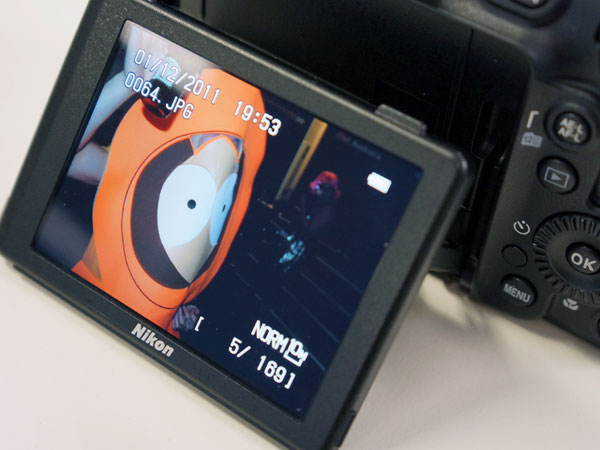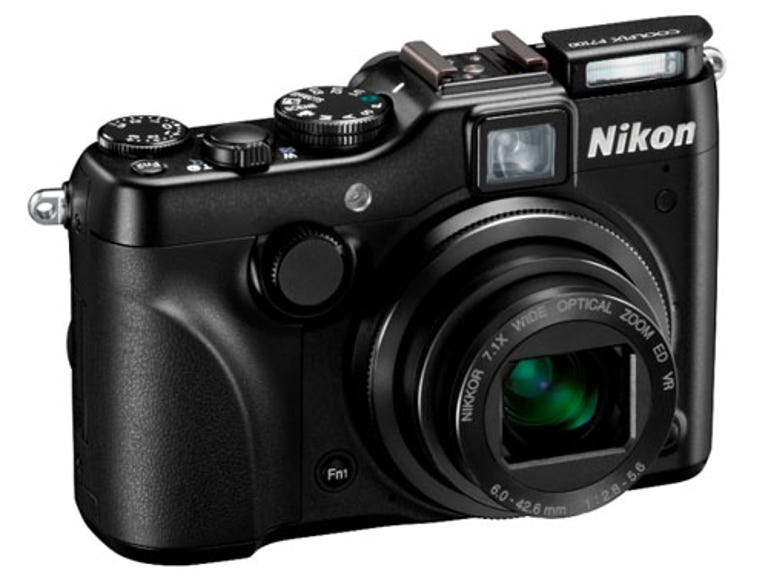 Why You Can Trust CNET
Why You Can Trust CNET Nikon Coolpix P7100 review: Nikon Coolpix P7100
While it's too large to fit inside a pocket, the P7100 provides all of the functionality and quality that you could need. It's a shame that its performance is not class beating, otherwise it would easily make a great companion to an SLR or ILC.
In 2010, Nikon released a strange camera onto the market. We say "strange" purely because it looked just like another camera already making waves in the same arena: the Canon PowerShot G12.
The Good
The Bad
The Bottom Line
Design and features
The P7100 is not significantly different from the P7000, the camera released last year, as it uses the same 10.1-megapixel 1/1.7-inch CCD sensor and 7x optical zoom lens with a maximum aperture range of f/2.8-5.6. Just by looking at the external casing, you can see how similar this looks to the Canon G12. The body shape borrows some familiar bumps over the lens barrel, which houses the hotshoe, and a small pop-up flash is nestled just above the Nikon logo.
It's one of the last few compact cameras, if you can call it that due to its 395g heft, to have an optical viewfinder. Along the top panel is a range of dials and buttons for tweaking common shooting settings. Adjustments to ISO, white balance, bracketing, picture control and photo quality can be made using the dial above the left hand side of the screen. A more standard mode dial with PASM, automatic, creative effect and custom settings is towards the middle, while a small exposure compensation dial is over towards the other end.

The screen on the P7100 can pop out from the body, allowing it to be tilted.
(Credit: CBSi)
The LCD screen has been given a tweak, maintaining its resolution at 921,000 dots, but having a flip-down design that pivots out from the body. A front control dial is quite intuitive for adjusting settings, and there's also one at the back, too, for quick changes to exposure in manual mode.
One addition that Nikon probably should have made to the P7100 is to have an instant-on record button somewhere on the body. To start recording, you first need to change the mode dial to the movie option, and then start filming by pressing the shutter button. It would be a great solution if the Fn2 button, conveniently placed near the shutter, could be customised as a record button, but it's limited to just four custom options, including a virtual horizon and histogram toggle.
A visual indication of how close 7x optical zoom gets you.
(Credit: CBSi)
Connectivity is provided via mini-HDMI and USB-out, while there's an external mic jack for more control over audio recording.
Compared to
| Nikon P7100 | Canon G12 | Panasonic LX5 | Canon S100 |
|---|---|---|---|
| 10-megapixel CCD (1/1.7-inch) | 10-megapixel CCD (1/1.7-inch) | 10.1-megapixel CCD (1/1.63-inch) | 12.1-megapixel CMOS (1/1.7-inch) |
| 3-inch, flip-down 920,000-dot LCD | 2.8-inch, 461,000-dot LCD | 3-inch, 460,000-dot LCD | 3-inch, 461,000-dot LCD |
| 7.1x optical zoom | 5x optical zoom | 4x optical zoom | 5x optical zoom |
| HD video (720p, 24fps) | HD video (720p, 24fps) | HD video (AVCHD Lite, 720p, 30fps) | HD video (H.264, 1080p, 24fps) |
| Pop-up flash, hotshoe | Built-in flash, hotshoe | Pop-up flash, hotshoe | Pop-up flash |
| 395g | 401g | 271g | 198g |
Performance
We conduct all of our performance testing on an SDHC, class 10 card. Even with a best-in-class memory card in the camera, the P7100's RAW shot-to-shot shooting is only marginally faster than the P7000. Nikon rates the battery for the P7100 at 350 shots.
Image quality
Nikon has tweaked the already-good image formula from the P7000 and left well enough alone in the P7100. Images on default settings have excellent colour rendition, good sharpness and minimal noise when shooting under ISO 400.
One issue with the P7100's shooting performance in low light is focus — the camera doesn't get it right every time. Some images can be slightly out of focus, because the P7100 has selected the wrong part of the image, even when a decent source of illumination (ie, the flash) is provided. Autofocus in ample light, however, is very quick and accurate.
Distortions from the lens are low, and chromatic aberrations are also pleasingly low. Images viewed at full magnification show some over-processing, particularly losing detail when zoomed in to the full 7x reach. White balance is accurate in outdoor, indoor and artificial light, and the camera produces pleasing skin tones when the flash is used in dark environments. RAW images provide a very similar level of detail as that found on the P7000; no surprise, given the sensors and lens are the same. See the P7000 review for a comparison.
Nikon calls its range of artistic filters "special effects", including such favourites as creative monochrome, painting, zoom exposure, defocus during exposure, cross process, soft, nostalgic sepia and high and low key, as well as selective colour. Some effects can be previewed on the screen (such as monochrome), but others like painting are only applied after the image is taken.
A range of filters from the P7100, including monochrome, cross process, painting and defocus during exposure.
(Credit: CBSi)
Video quality is excellent and on par with the latest improvements in recording on the rest of the 2011 Coolpix range. Audio is well defined, with even loud music being controlled by the built-in microphone. There are two focusing options when filming: single and full-time continuous AF.
Image samples
Exposure: 1/80, f/4, ISO 100 | Exposure: 1/800, f/2.8, ISO 100 |
Exposure: 1/30, f/3.5, ISO 220 | Exposure: 1/400, f/2.8, ISO 100 |
Conclusion
While it's too large to fit inside a pocket, the P7100 provides all of the functionality and quality that you could need. It's a shame that its performance is not class beating, otherwise it would easily make a great companion to an SLR or ILC.


